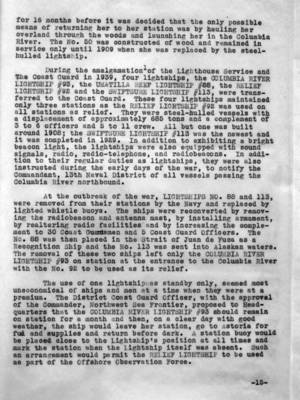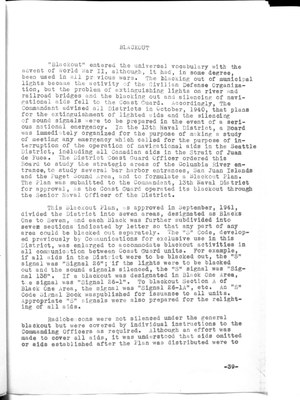Pages That Mention sound signals
Coast Guard District narrative histories 1945
34
for 16 months before it was decided that the only possible means of returning her to her station was by hauling her overland through the woods and launching her in the Columbia River. The No. 50 was constructed of wood and remained in service only until 1909 when she was replaced by the steel-hulled lightship.
During the amalgamation of the Lighthouse Service and The Coast Guard in 1939, four lightships, the COLUMBIA RIVER LIGHTSHIP 393, the UMATILLA REEF LIGHTSHIP #88, the RELIEF LIGHTSHIP #92 and the SWIFTSURE LIGHTSHIP #113, were transferred to the Coast Guard. These four lightships maintained only three stations as the RELIEF LIGHTSHIP #92 was used on all stations as relief. They were steel-hulled vessels with a displacement of approximately 685 tones and a complement of 3 to 6 officers and 5 to 11 crew. All but one was built around 1908; the SWIFTSURE LIGHTSHIP #113 was the newest and it was completed in 1929. In addition to exhibiting a bright beacon light, the lightships were also equipped with sound signals, [radio]], radio-telephone, and radiobeacons. In addition to their regular duties as lightships, they were also instructed during the early days of the war, to notify the Commandant, 13th Naval District of all vessels passing the Columbia River northbound.
At the outbreak of the war, LIGHTSHIPS NO. 88 and 113, were removed from their stations by the Navy and replaced by lighted whistle buoys. The ships were reconverted by removing the radiobeacon and antenna mast, by installing armament, by realtering radio facilities and by increasing the complement to 30 Coast Guardsmen and 5 Coast Guard Officers. The No. 88 was then placed in the Strait of Juan de Fuca as a Recognition Ship and the No 113 was sent into Alaskan waters. The removal of these two ships left only the COLUMBIA RIVER LIGHTSHIP #93 on station at the entrance to the Columbia River with the No. 92 to be used as its relief.
The use of one lightship as standby only, seemed most uneconomical of ships and men at a time when they were at a premium. The District Coast Guard Officer, with the approval of the Commander, Northwest Sea Frontier, proposed to Headquarters that the COLUMBIA RIVER LIGHTSHIP #93 should remain on station for a month and then, on a clear day with good weather, the ship would leave her station, go to Astoria for fuel and supplies and return before dark. A station buoy would be placed close to the Lightship's position at all times and mark the station when the Lightship itself was absent. Such an arrangement would permit the RELIEF LIGHTSHIP to be used as part of the Offshore Observation Force.
59
"Blackout" entered the universal vocabulary with the advent of World War II, although, it had, in some degree, been used in all previous wars. The blacking out of municipal lights became the activity of the Civilian Defense Organization, but the problem of extinguishing lights on river and railroad bridges and the blacking out and silencing of navigational aids fell to the Coast Guard. Accordingly, The Commandant advised all Districts in October, 1940, that plans for the extinguishment of lighted aids and the silencing of sound signals were to be prepared in the event of a serious national emergency. In the 13th Naval District, a Board was immediately organized for the purpose of making a study of meeting any emergency which called for the purpose of interruption of the operation of navigational aids in the Seattle District, including all Canadian aids in the Strait of Juan de Fuca. The District Coast Guard Officer ordered this Board to study the Strategic areas of the Columbia River entrance, to study several bar harbor entrances, San Juan Islands and the Puget Sound Area, and to formulate a Blackout Plan. The Plan was submitted to the Commandant, 13th Naval District for approval, as the Coast Guard operated its blackout through the Senior Naval Officer of the District.
This Blackout Plan, as approved in September, 1941, divided the District into seven areas, designated as Blacks One to Seven, and each Black was further subdivided into seven sections indicated by letter so that any part of any area could be blacked out separately. The "S" Code, developed previously by Communications for exclusive use in this District, was enlarged to accommodate blackout activities in all communication between Coast Guard units. For example, if all aids in the District were to be blacked out, the "S" signal was "Signal 26"; if the lights were to be blacked out and the sound signals silenced, the "S" signal was "Signal 138". If a blackout was designated in Black One Area, the signal was "Signal 26-1A", etc. An "S" Code Signal Book was published for issuance to all units. Appropriate "S" signals were also prepared for the relighting of all aids.
Radiobeacons were not silenced under the general blackout but were covered by individual instructions to the Commanding Officers as required. Although an effort was made to cover all aids, it was understood that aids omitted or aids established after the Plan was distributed were to
-39-

